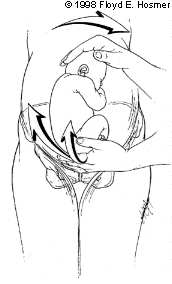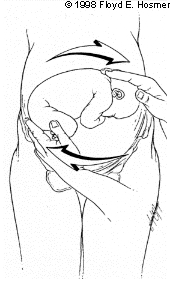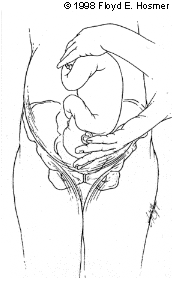
Am Fam Physician. 1998;58(3):744-746
See related article on external cephalic version.
What is a breech birth?
Before birth, most babies are in a head-down position in the mother's uterus. That's why most babies are born headfirst. Sometimes the part of the baby that is head down is not the head, but the buttocks or the feet. When a baby is in that position before birth, it's called a breech birth or breech baby. Many babies are breech early in pregnancy, but most of them turn to the headfirst position near the end of the pregnancy. Babies that are born early are more likely to be breech. If more than one baby is in the uterus at one time, one or more of the babies may be breech. Abnormal levels of amniotic fluid around the baby may result in a breech birth. As you get closer to your due date, your doctor will be able to tell (by physical exam, ultrasound, or both) if your baby is breech.
Can a breech baby be delivered without a cesarean?
Some breech babies may be safely delivered from the vagina. However, more complications can occur if the baby is breech. A baby who is breech may be very small, or it may have birth defects. Breech babies may also have accidents during delivery that can damage the umbilical cord or cause asphyxia, or even cause death of the mother or baby.
Although breech babies can be delivered vaginally, it's generally safer and easier to deliver babies head first from the vagina. So, many times doctors deliver breech babies by cesarean delivery (c-section). Risks are involved with cesarean delivery, too, such as bleeding, infection and longer hospital stays for both the mother and her baby.
Can I do anything to help if my baby is breech?
It's very important to see your doctor regularly when you're pregnant. Your doctor can tell if your baby is breech and help plan what to do. Some doctors will plan to deliver the baby by cesarean section. Others may give their patients exercises to do at home that may help turn the baby to the head-first position. Some doctors try to turn the baby in the mother's uterus using a procedure called external cephalic version. If this procedure is successful and the baby stays head down, a normal vaginal delivery is more likely.
What is external cephalic version?
External cephalic version is a way to try to turn a baby from breech position to vertex (head-down) position while it's still in the mother's uterus. In other words, external cephalic version means turning the baby from outside of the abdomen so that it's in the head-down position. Your doctor will use his or her hands on the outside of your abdomen (tummy) to try to turn the baby (see the pictures).



When is external cephalic version done?
External cephalic version is done at the end of pregnancy, after about 37 weeks of gestation.
Who can have external cephalic version?
Many women with normal pregnancies may have external cephalic version. Women who can't have it are women with one of the following:
Vaginal bleeding
A placenta that is near or covering the opening of the uterus
A nonreactive nonstress test
An abnormally small baby
A low level of fluid in the sac that surrounds and protects the baby
An abnormal fetal heart rate
Premature rupture of the membranes
Twins or other multiple pregnancy
What are the risks of external cephalic version?
External cephalic version has some risks, including the following:
Premature labor
Premature rupture of the membranes
A small blood loss for either the baby or the mother
Fetal distress leading to an emergency cesarean delivery
The baby might turn back to the breech position after the external cephalic version is done
Although the risk of having these complications is small, some doctors prefer not to try an external cephalic version.
What can I expect if my doctor and I decide to try external cephalic version?
External cephalic version is usually done in the hospital. Before the procedure, you will have an ultrasound to confirm that the baby is breech. Your doctor will also do a nonstress test to make sure that the baby's heart rate is normal. A tube of blood will be drawn, and an anesthesiologist will be notified, just in case you need to have an emergency cesarean delivery. You'll be given medicine through a vein in your arm to relax your uterus. This medicine is very safe, with no risk to your baby. While you're lying down, the doctor will place his or her hands on the outside of your abdomen. After locating the baby's head, the doctor will gently try to turn the baby to the vertex position.
What happens after the procedure?
When the procedure is completed, your doctor will perform another nonstress test. If everything is normal, you won't have to stay in the hospital. If the procedure isn't successful, your doctor will talk to you about the possibility of having a vaginal delivery or a cesarean section. Your doctor may also suggest repeating the external cephalic version.
What is the success rate of external cephalic version?
The success rate of external cephalic version depends on several factors, including the following:
How close you are to your due date
How much fluid is around the baby
How many pregnancies you've had
How much your baby weighs
How the placenta is positioned
How your baby is positioned
The average success rate is about 65 percent. Even if the procedure works at first, there's still a chance that the baby will turn back around to the breech position. This also depends on the factors listed above.